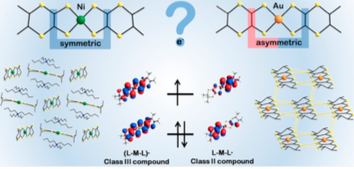Localization versus delocalization in chiral single component conductors of gold bis(dithiolene) complexes
Localization versus delocalization in chiral single component conductors of gold bis(dithiolene) complexes
D.G. Branzea, F. Pop, P. Auban-Senzier, R. Cleŕac, P.Alemany, E. Canadell, N. Avarvari.
J. Am. Chem. Soc., 138 (2016) 6838.

Neutral [Au(dm-dddt)2] complexes have an asymmetric structure and a mixed-valence nature with important consequences in its electrical conductivity in the solid state.
In this work we report the first examples of chiral single component conductors. Both (S,S) and (R,R) enantiomers of the 5,6-dimethyl-5,6-dihydro-1,4-dithiin-2,3-dithiolate (dm- dddt) ligand have been used to prepare neutral [M(dm-dddt)2] (M = Au, Ni) complexes. The most peculiar structural feature concerns a dissymmetry between the two dithiolene moieties for the Au compound, while the Ni counterpart is symmetric. Resistivity measurements show thermally activated behaviour for the open-shell gold complexes, with activation energies strongly influenced by hydrostatic pressure. A thorough theoretical study on Ni anion radical and Au neutral radical bis(dithiolene) complexes addressing the issue of symmetry versus asymmetry from an electronic coupling perspective between the two dithiolene ligands is presented. It results that neutral Au complexes with dithiolene ligands without extended delocalization are Class II mixed-valent compounds in the Robin and Day classification, presenting an inherent tendency toward asymmetric structures, which can be however modulated by the intermolecular organization in the solid state.
